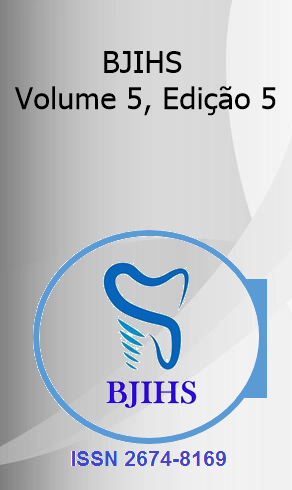Abstract
INTRODUCTION: Colorectal cancer (CRC) is a neoplasm that attacks the large intestine (colon) and/or rectum. Related to nutrition, in which increased intake of animal fat causes mutation and cytotoxicity. Red and processed meat, low intake of dietary fiber and vegetables contribute to solid tumor growth. The initial symptoms depend on the characteristics of the tumor and its location, tumors that are in the right colon region lead to diarrhea and vague pain in the abdomen (dyspeptic syndrome). However, in Brazil, primary health care fails to carry out the educational aspect in a broad way. OBJECTIVE: To describe the epidemiological profile of Malignant Colon Neoplasia in Brazil between 2017 to 2022. METHODOLOGY: Descriptive cross-sectional study with a quantitative and qualitative approach, based on the collection of data present in the Hospital Information System, hosted at DATASUS on Malignant Colon Neoplasia, reported in Brazil between the periods of January 2017 to December 2022. The data totaled 313,175 cases in this period. The indicators used were: federation units; gender; age group; and region of occurrence. For the literature review, the keywords and the main subject about Malignant Colon Neoplasia were relevant using the SciELO and PubMed database platforms. Articles published in the last 16 years were selected and focused on describing the cause of the main forms of proliferation and defining the problems that increase the infection of the Brazilian population. RESULTS: The number of hospitalizations for cases of Malignant Colon Neoplasia was 313,175, with the Southeast region having the highest incidence, with 140,809 (44, 96%) cases. Males had 155,479 (49.64%) cases and females had around 157,696 (50.35%). Adults over 45 years of age have the highest incidences with 271,717 (86.76%) cases, with patients between 60 and 64 years of age having the highest number (n=47,279). In relation to deaths, there were 25,176 (8.38%), being higher in elderly patients, over 60 years old, with 17,333 (68.84%) cases. The Southeast region has the highest mortality rate, 14,003 (55.62%) cases. CONCLUSION: Therefore, screening and prevention of this neoplasm in the single health system is essential, through consultations, exams such as colonoscopy and prevention and awareness actions regarding healthier habits, thus aiming not only to incidence of this neoplasia as well as its mortality.
References
BUSTAMANTE-LOPEZ, L. A., NAHAS, S. C., NAHAS, C. S. R., PINTO, R. A., MARQUES, C. F. S., & CECCONELLO, I.. (2019). IS THERE A DIFFERENCE BETWEEN RIGHT- VERSUS LEFT-SIDED COLON CANCERS? DOES SIDE MAKE ANY DIFFERENCE IN LONG-TERM FOLLOW-UP?. ABCD. Arquivos
Brasileiros De Cirurgia Digestiva (são Paulo) 32(4), e1479.
Cruz GMG da, Santana JL, Santana SKA de A, Constantino JRM, Chamone BC, Ferreira RMRS, et al.. Câncer colônico - epidemiologia, diagnóstico, estadiamento e gradação tumoral de 490 pacientes. Rev bras colo-proctol [Internet]. 2007Apr;27(2):139–53.
DA ROCHA LOBO, Fernanda Laraia; DEL GIGLIO, Auro; DA COSTA AGUIAR,
Pedro. Perfil epidemiológico do câncer colorretal. Clinical Oncology Letters,
n. AheadOfPrint, p. 0-0, 2020.
DA SILVA, Márcio; ERRANTE, Paolo Ruggero. Câncer colorretal: fatores de risco, diagnóstico e tratamento. UNILUS Ensino e Pesquisa, v. 13, n. 33, p. 133-140, 2017.
FIDELLE, Marine et al. Resolving the paradox of colon cancer through the integration of genetics, immunology, and the microbiota. Frontiers in immunology, v. 11, p. 600886, 2020.
JOHN, Hee-Kyung et al. Simple sugar and sugar-sweetened beverage intake during adolescence and risk of colorectal cancer precursors. Gastroenterology, v. 161, n. 1, p. 128-142. e20, 2021.
MARTIN, Francis L. et al. Age-related and gender-related increases in colorectal cancer mortality rates in Brazil between 1979 and 2015: projections for continuing rises in disease. Journal of Gastrointestinal Cancer, v. 52, p. 280-288, 202
TENG, Annabelle et al. Colon cancer as a subsequent malignant neoplasm in young adults.
Cancer, v. 125, n. 21, p. 3749-3754, 2019. (TENG A. et al., 2019)
WALDUM, Helge; FOSSMARK, Reidar. Inflammation and Digestive Cancer. International Journal of Molecular Sciences, v. 24, n. 17, p. 13503, 2023.
ZHANG, Xiao Li et al. A possible genetic association between obesity and colon cancer in females. Frontiers in Endocrinology, v. 14, p. 1189570, 2023.

This work is licensed under a Creative Commons Attribution 4.0 International License.
Copyright (c) 2023 Jhennifer Oliveira Vimercati, Victor Salarolli Lorencini, Maria Clara Queiroz Alves, Sara dos Santos Carolino, Raffael Nazario Laurentino, Armando Nazario Ribeiro, Matheus Kalleb Almeida de Arruda Santos, Davi Rosalino Leoni
